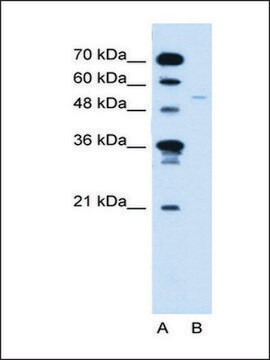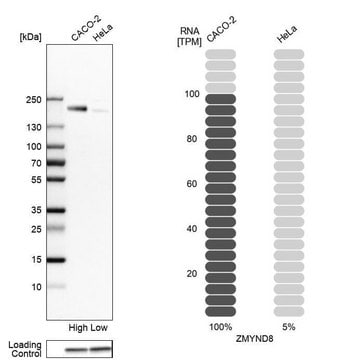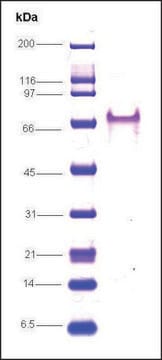SRP2047
RXR, β human
recombinant, expressed in insect cells, ≥80% (SDS-PAGE)
Synonym(s):
DAUDI6, H-2RIIBP, MGC1831, NR2B2, RCoR-1
Sign Into View Organizational & Contract Pricing
All Photos(1)
About This Item
UNSPSC Code:
12352200
NACRES:
NA.26
Recommended Products
biological source
human
recombinant
expressed in insect cells
Assay
≥80% (SDS-PAGE)
form
frozen liquid
mol wt
~58.6 kDa
packaging
pkg of 5 μg
storage condition
avoid repeated freeze/thaw cycles
concentration
450 μg/mL
color
clear colorless
NCBI accession no.
UniProt accession no.
shipped in
dry ice
storage temp.
−70°C
Gene Information
human ... RXRB(6257)
Biochem/physiol Actions
Retinoid X receptor (RXR) serves as a promiscuous heterodimerization partner for many nuclear receptors through the identity box, a 40-amino acid subregion within the ligand binding domain. RXR partners include thyroid hormone receptors (TRs), retinoic acid receptors (RARs), peroxisome proliferator-activated receptor (PPAR), several constitutive active orphan nuclear receptors, e.g. nuclear growth factor I-B (NGFI-B), oxysterol receptors (FXR,LXR), and constitutive androstane receptors (CAR). RXRs also form homodimers to mediate the effects of 9-cis-retinoic acid (9-cRA). Depending on these protein-protein interactions, RXR-containing complexes have distinct ligand-dependent and constitutive functions. RXRβ was originally identified as a protein able to bind to the regulatory region II of the murine major histocompatibility complex (MHC) class I promoter and referred to as H2RIIBP. The human RXRβ gene has been mapped to the short arm or centromeric region of chromosome 6 (6pter-q13) which also contains the MHC I locus. Two major RXRb isoforms in the mouse, designated RXRβ1 and RXRβ2 (GenBank accession numbers D21830 and D21831), differ in the N-terminal (A) domain with RXRβ1 containing an extra 72 amino acids. These isoform mRNAs are transcribed from two CpG island promoters and the different N-terminal exons are spliced to exons common to both isoforms from the remainder of the gene. Although the two mouse RXR isoforms have been characterised in some detail, less information is available about their human counterparts. Since the expression of different RXR isoforms appears to be well conserved between species, each receptor isoform may hold a specific role in retinoid signalling. However, many RXR expression studies have not recognised the importance of establishing which RXR isoforms are expressed in a particular system. RXRβ is predominantly involved in retinoid responses in the N-type SH SY 5Y and the S-type SH S EP neuroblastoma cells, both derivatives of a mixed phenotype neuroblastoma cell line.
Physical form
Clear and colorless frozen liquid solution
Preparation Note
Use a manual defrost freezer and avoid repeated freeze-thaw cycles. While working, please keep sample on ice.
Storage Class Code
10 - Combustible liquids
WGK
WGK 1
Flash Point(F)
Not applicable
Flash Point(C)
Not applicable
Certificates of Analysis (COA)
Search for Certificates of Analysis (COA) by entering the products Lot/Batch Number. Lot and Batch Numbers can be found on a product’s label following the words ‘Lot’ or ‘Batch’.
Already Own This Product?
Find documentation for the products that you have recently purchased in the Document Library.
K Fleischhauer et al.
Human genetics, 90(5), 505-510 (1993-01-01)
The murine retinoid X receptor beta (mRXR beta) is a nuclear hormone receptor that activates transcription of murine major histocompatibility complex (MHC) class I genes in response to retinoic acid. In this study, the human RXR beta gene was mapped
P Chambon
FASEB journal : official publication of the Federation of American Societies for Experimental Biology, 10(9), 940-954 (1996-07-01)
Retinoids play an important role in development, differentiation, and homeostasis. The discovery of retinoid receptors belonging to the superfamily of nuclear ligand-activated transcriptional regulators has revolutionized our molecular understanding as to how these structurally simple molecules exert their pleiotropic effects.
K Hamada et al.
Proceedings of the National Academy of Sciences of the United States of America, 86(21), 8289-8293 (1989-11-01)
Transcription of major histocompatibility complex (MHC) class I genes is regulated by the conserved MHC class I regulatory element (CRE). The CRE has two factor-binding sites, region I and region II, both of which elicit enhancer function. By screening a
Our team of scientists has experience in all areas of research including Life Science, Material Science, Chemical Synthesis, Chromatography, Analytical and many others.
Contact Technical Service








